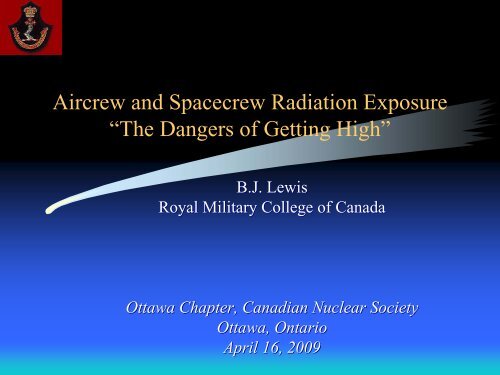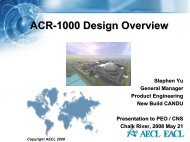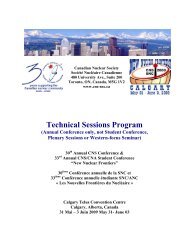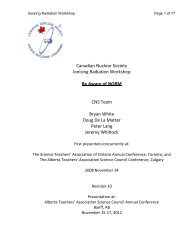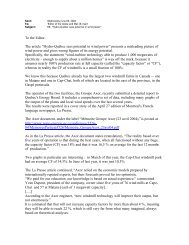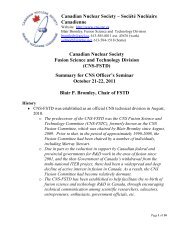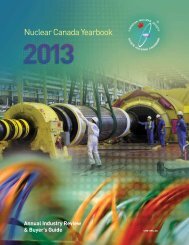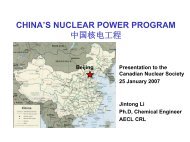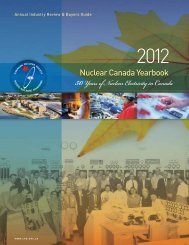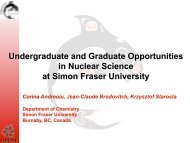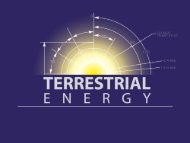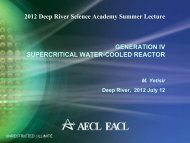Aircrew and Spacecrew Radiation Exposure - media.cns-snc.ca
Aircrew and Spacecrew Radiation Exposure - media.cns-snc.ca
Aircrew and Spacecrew Radiation Exposure - media.cns-snc.ca
Create successful ePaper yourself
Turn your PDF publications into a flip-book with our unique Google optimized e-Paper software.
<strong>Aircrew</strong> <strong>and</strong> <strong>Spacecrew</strong> <strong>Radiation</strong> <strong>Exposure</strong><br />
“The Dangers of Getting High”<br />
B.J. Lewis<br />
Royal Military College of Canada<br />
Ottawa Chapter, Canadian Nuclear Society<br />
Ottawa, Ontario<br />
April 16, 2009
Outline<br />
<strong>Aircrew</strong> <strong>Radiation</strong> <strong>Exposure</strong> Assessment<br />
Measurements <strong>and</strong> Computer Code Development<br />
Space <strong>Radiation</strong> Monitoring
Typi<strong>ca</strong>l Annual <strong>Radiation</strong> <strong>Exposure</strong><br />
Total Average Annual <strong>Exposure</strong> 3.6 mSv
Impetus<br />
• ICRP-60 (1990) <strong>and</strong> ICRP-103 (2007):<br />
– Reduce radiation exposure limits:<br />
• Nuclear Energy Worker (NEW): 50 to 20 mSv/year<br />
• Public: 5 to 1 mSv/year<br />
– Recognize occupational exposure of aircrew to radiation
• European Union<br />
<strong>Aircrew</strong> <strong>Radiation</strong> Regulation<br />
(Basic Safety St<strong>and</strong>ard Directive, May 2000)<br />
• Canada<br />
(Transport Canada, Commercial <strong>and</strong> Business<br />
Aviation Advisory Circular, April 2001)<br />
– Account for exposure for >1 mSv/y (> 8 km)<br />
• Assess exposure<br />
• Adjust working schedules (> 6 mSv action level)<br />
• Inform workers<br />
• Control doses during pregnancy (
Epidemiologi<strong>ca</strong>l Studies<br />
• P. B<strong>and</strong> et al., B.C. Cancer Foundation (Cdn/AC Pilots, 1950-1992)<br />
– Excess AML <strong>and</strong> prostatic <strong>ca</strong>ncer<br />
• J. Grayson et al., Brooks AFB (USAF Pilots, 1975-1989)<br />
– Excess <strong>ca</strong>ncer in all sites, testis & urinary bladder<br />
• E. Pukkala et al, Finnish Cancer Registry (FAs, 1967-1992)<br />
– Excess female breast <strong>and</strong> bone <strong>ca</strong>ncer<br />
• European Study of Cancer Among flying PErsonnel (ESCAPE) (9 countries) (1960-1997)<br />
– S<strong>ca</strong>rce evidence for specific occupational <strong>ca</strong>ncer risk<br />
– Revised interest with ESCAPE II (or COSMIC) study to include US PAN AM cohort<br />
• D. Irvine, British Airways Pilots, 1998<br />
• B. Grajewski, NIOSH Studies (FA (1998-2000), Pilots (2001))<br />
– FAs reproductive health effects<br />
– Biomarker study of pilots
<strong>Radiation</strong> <strong>Exposure</strong> to <strong>Aircrew</strong><br />
Galactic Cosmic Rays<br />
(GCR)<br />
Complex mixed-radiation field<br />
Solar Particle Events<br />
(SPE)
Galactic Cosmic Ray (GCR) <strong>Exposure</strong> Conditions<br />
• Relatively constant field dependent upon:<br />
• Solar Activity<br />
• Latitude<br />
• Altitude<br />
• Compli<strong>ca</strong>ted field<br />
• Many particle types, large energy range<br />
• Greater uncertainty in biologi<strong>ca</strong>l risk
Solar Magnetic Field Shielding<br />
(When)<br />
• GCR intensity anticoincident with solar cycle<br />
Sunspot Number<br />
400<br />
350<br />
300<br />
250<br />
200<br />
150<br />
100<br />
50<br />
0<br />
19 20 21 22 23<br />
1953 1958 1963 1968 1973 1978 1983 1988 1993 1998 2003 2008<br />
Year<br />
4500<br />
4000<br />
3500<br />
3000<br />
2500<br />
2000<br />
1500<br />
Climax Hourly Count Rate /100
Earth Magnetic Field Shielding<br />
(Where)<br />
• Greater shielding at equator than<br />
geomagnetic poles (factor of ~3)
40 km<br />
20 km<br />
10 km<br />
1 km<br />
Atmospheric Shielding<br />
(How High)<br />
Satellite<br />
Balloon<br />
Supersonic<br />
Subsonic<br />
High Peaks<br />
Atmospheric<br />
Nucleus
Equipment Suite Development<br />
Anthropomorphic Phantom<br />
with TLDs <strong>and</strong> BDs<br />
MNS<br />
NE213 Scintillator<br />
LET Chamber<br />
LLRM<br />
Detector NIMs, Computers, UPS<br />
BGO<br />
Scintillators
Commercial Aircraft Measurement<br />
Eberline<br />
NRD<br />
SWENDI Ionization<br />
Chamber<br />
TEPC SWENDI
<strong>Aircrew</strong> <strong>Radiation</strong> Studies<br />
Experimentation<br />
• ~250 Flights (Portable Instruments)<br />
• Ionization Counter/Al 2O 3 TLDs (low-LET)<br />
• SWENDI Remmeter/Bubble Detectors (high-LET)<br />
• Liulin-4N <strong>and</strong> 4SN (Si-based) LET Spectrometers<br />
• Tissue Equivalent Proportional Counter (Hawk TEPC)<br />
Model/Code Development<br />
• Predictive Code AIrcrew <strong>Radiation</strong> <strong>Exposure</strong> (PCAIRE)
Ambient Dose Equivalent Distribution (μSv)<br />
60<br />
40<br />
20<br />
0<br />
TEPC IC TLD SWENDI BD<br />
TOTAL = IONIZING + NEUTRON
Quality Factor<br />
Q>1<br />
Q=20<br />
Lung<br />
4%<br />
Ionizing<br />
(low-LET) (low LET)<br />
Other<br />
3%<br />
Q=1<br />
Q>1<br />
Gamma<br />
62%<br />
X-Ray Ray<br />
Q=1<br />
38%<br />
1<br />
1<br />
93% Electron<br />
1<br />
Neutrons<br />
(high-LET) (high US Atomic LET) <strong>Radiation</strong> Workers<br />
<strong>Aircrew</strong><br />
20
TEPC Data from Selected Flight Routes<br />
Global Flight Group Flight<br />
Time (h)<br />
Trans-Pacific (CYVR-KIX)<br />
Trans-Atlantic (CYYZ-LHR)<br />
Trans-Canada (CYYZ-CYVR)<br />
Caribbean (BGI-CYYZ)<br />
Northwest/Yukon (CYOW-CYFB<br />
CYRB-CYSR-CYFB-CYOW)<br />
10.2<br />
6.5<br />
5.0<br />
5.7<br />
10.2<br />
Total Dose<br />
Eq. (μSv)<br />
57 ± 9<br />
39 ± 6<br />
35 ± 5<br />
27 ± 4<br />
54 ± 28<br />
Q<br />
2.2 ± 0.4<br />
2.5 ± 0.4<br />
2.4 ± 0.4<br />
2.2 ± 0.4<br />
3.4 ± 0.6
HNL<br />
Data Coverage<br />
LP PD<br />
DIAP<br />
PGUA
Count Rate (Counts/M in)<br />
2500<br />
2000<br />
1500<br />
1000<br />
500<br />
0<br />
TEPC Count Rate<br />
Constant Latitude<br />
0:00 1:00 2:00 3:00 4:00 5:00 6:00 7:00<br />
Time (Z)<br />
Heading North<br />
19:00 20:00 21:00 22:00 23:00 0:00 1:00 2:00<br />
Time (Z)<br />
40000<br />
35000<br />
30000<br />
25000<br />
20000<br />
15000<br />
10000<br />
5000<br />
0<br />
Altitude (ft)
Ambient Dose Equivalent Rate (uSv/h)<br />
10<br />
0.1<br />
1<br />
YGK-YYZ-HGK Polar Flight (2005)<br />
Toronto to Hong Kong Hong Kong to Toronto<br />
IC+SWENDI<br />
4/18/05 9:00 4/18/05 21:00 4/19/05 9:00 4/19/05 21:00 4/20/05 9:00 4/20/05 21:00<br />
HAWK<br />
FH41B<br />
LiuLin<br />
FH41B Corrected<br />
Flight Altitude<br />
Date <strong>and</strong> Time<br />
YGK-YYZ YYZ-HGK (polar) HGK HGK-YYZ YYZ-YGK<br />
12000<br />
10000<br />
8000<br />
6000<br />
4000<br />
2000<br />
0<br />
Altitude (m)
TEPC Data Analysis<br />
Geomagnetic latitude <strong>ca</strong>lculated from geographic latitude & longitude longitude<br />
Ambient Total Dose Equivalent Rate, H (μSv/h)<br />
.<br />
16<br />
14<br />
12<br />
10<br />
8<br />
6<br />
4<br />
2<br />
9.4 km<br />
10.0 km (+2 μSv/h)<br />
10.6 km (+4 μSv/h)<br />
11.2 km (+6 μSv/h)<br />
11.8 km (+8 μSv/h)<br />
Best Fit at 10.6 km<br />
0<br />
-45 -30 -15 0 15 30 45 60 75 90<br />
Geomagnetic Latitude, B m (deg)
Ambient Dose Equivalent Rate (μSv/h)<br />
Latitude Dependence:<br />
Dose Rate Vs Cutoff Rigidity<br />
Ambient dose equivalent rate (35000 ft)<br />
.<br />
10<br />
8<br />
6<br />
4<br />
2<br />
0<br />
0 2 4 6 8 10 12 14 16 18<br />
Cutoff Rigidity, Rc (GV)<br />
North<br />
South<br />
Best Fit<br />
GCR ability to penetrate magnetic<br />
field<br />
Global<br />
Cutoff<br />
Rigidity<br />
Contours
40 km<br />
20 km<br />
10 km<br />
1 km<br />
Altitude Effect (Balloon Flights)<br />
Satellite<br />
Balloon<br />
Supersonic<br />
Subsonic<br />
High Peaks<br />
Atmospheric<br />
Nucleus<br />
fAlt<br />
10<br />
1<br />
0.1<br />
0.01<br />
Balloon Data (July 14, 2001)<br />
Balloon Data (July 23, 2001)<br />
Model<br />
0 200 400 600 800 1000<br />
Atmospheric Depth h (g / cm 2 )
Ambient dose equivalent rate (μSv/h)<br />
normalized to 10.6 km<br />
Poles<br />
8<br />
6<br />
4<br />
2<br />
0<br />
Solar Cycle Effect (10.7 km)<br />
RMC IC+SWENDI (Climax = 3744 counts/h/100, Φ = 984 MV)<br />
ACREM IC+NMX (Climax = 4277 counts/h/100, Φ = 498 MV)<br />
Best Fit ACREM IC+NMX<br />
Best Fit RMC IC+SWENDI<br />
IC + SWENDI<br />
0 2 4 6 8 10 12 14 16 18<br />
Verti<strong>ca</strong>l cutoff rigidity Rc (MV)<br />
Equator
PCAIRE Code<br />
Visual_PCAIRE.exe
PCAIRE Code vs Concorde/ER-2 (NASA)<br />
(High-Altitude)<br />
TEPC Measured Route Dose (uSv)<br />
160<br />
140<br />
120<br />
100<br />
80<br />
60<br />
40<br />
20<br />
0<br />
Heliocentric Potential (FAA)<br />
Deceleration Parameter (NASA)<br />
ER-2 North 2<br />
Concorde Flights<br />
ER-2 South 1 & 2<br />
ER-2 East<br />
ER-2 North 1<br />
15.2 -18 km (Concorde)<br />
15.2 - 21 km (ER-2)<br />
0 20 40 60 80 100 120 140 160<br />
PCAIRE Predicted Route Dose (μSv)
PC-AIRE Prediction of Annual<br />
Dose Equivalent (mSv)<br />
6<br />
5<br />
4<br />
3<br />
2<br />
1<br />
0<br />
<strong>Aircrew</strong> Annual <strong>Exposure</strong><br />
ICRP 60 Public Limit<br />
Flight Attendants Pilots
Canadian Annual Occupational <strong>Exposure</strong>s<br />
Average <strong>Exposure</strong><br />
(mSv/year)<br />
6<br />
4<br />
2<br />
0<br />
99-EHD-239<br />
Occupation<br />
Nuclear Fuel<br />
H<strong>and</strong>ler<br />
Industrial<br />
Radiographer<br />
Uranium Miner<br />
Nuclear Medicine<br />
Technologist<br />
Commercial<br />
<strong>Aircrew</strong>
Health Impact<br />
• ~25% of population will develop fatal <strong>ca</strong>ncer<br />
• If aircrew exposed to 6 mSv/y over 30 years, risk of<br />
developing a fatal <strong>ca</strong>ncer: 6 mSv/y x 30 y x 4 x10-5 <strong>ca</strong>ncers/mSv = 0.7%
<strong>Radiation</strong> <strong>Exposure</strong> from Solar Particle<br />
Events (SPE)<br />
• Highly sporadic events associated with<br />
solar flares <strong>and</strong> coronal mass ejection<br />
– Additional exposure to aircrew
<strong>Aircrew</strong> <strong>Exposure</strong> from SPEs<br />
• Propagate GCR <strong>and</strong> GOES-11 spectra (p, He) through<br />
atmosphere with Monte Carlo Code (MCNPX)<br />
Proton Flux (n/MeV/sr/cm 2 )<br />
GCR<br />
Proton energy (MeV)<br />
SPE
Dose Rate<br />
E&<br />
, H&<br />
Dose <strong>and</strong> NM Count Rate Prediction<br />
( Sv<br />
C&<br />
( count<br />
h<br />
h<br />
NM Count Rate<br />
−1<br />
−1<br />
) =<br />
) =<br />
m<br />
⎡<br />
∑∑ ⎢<br />
⎣<br />
i=<br />
1 j=<br />
1<br />
m<br />
⎡<br />
∑∑ ⎢<br />
⎣<br />
n<br />
n<br />
i=<br />
1 j=<br />
1<br />
⎧<br />
⎨c<br />
⋅ΔE<br />
⎩<br />
⎧<br />
⎨c<br />
⋅ΔE<br />
⎩<br />
Energy bin width<br />
Global Cutoff<br />
Rigidity<br />
Contours<br />
Dose Conversion<br />
Coefficient<br />
i,<br />
i+<br />
1<br />
i,<br />
i+<br />
1<br />
⋅ K<br />
⋅ R<br />
j<br />
j<br />
⎛ 3600s<br />
⎞⎫<br />
⋅ Pij<br />
⋅⎜<br />
⎟⎬Φ&<br />
⎝ h ⎠⎭<br />
⋅ P<br />
ij<br />
⎛ 3600s<br />
⎞⎫<br />
⋅⎜<br />
⎟⎬Φ&<br />
⎝ h ⎠⎭<br />
NM Response Function<br />
prim<br />
E,<br />
Ωi<br />
prim<br />
E,<br />
Ωi<br />
⎤<br />
⎥ =<br />
⎦<br />
⎤<br />
⎥ =<br />
⎦<br />
m<br />
∑<br />
i=<br />
1<br />
m<br />
∑<br />
i=<br />
1<br />
MCNPX matrix coefficients<br />
Primary GOES<br />
spectrum<br />
P<br />
P<br />
A<br />
NM<br />
Noisy Sun Effects<br />
prim ( E ) Φ&<br />
( E )<br />
i<br />
E,<br />
Ω<br />
prim ( E ) Φ&<br />
( E )<br />
i<br />
E,<br />
Ω<br />
i<br />
i
Solar Storm Effects <strong>and</strong> Solar Flare Anisotropy<br />
"SOHO (ESA & NASA)"
Count Rate (C/s)<br />
Neutron Monitor Analysis<br />
1.E+04<br />
1.E+03<br />
1.E+02<br />
1.E+01<br />
1.E-01<br />
Neutron monitor peak count rate - April 15 th , 2001<br />
RMC Model (3 km)<br />
RMC Model (0 km)<br />
1.E+00<br />
100 1000 10000<br />
Effective Cutoff Rigidity (MV)<br />
RMC Model (0 km) Thule Oulu<br />
Cape Schmidt Lomniky Stit Magadan<br />
Irkutsk Alma Ata Apatity<br />
Jungfraujoch Kiel Newark<br />
Rome Yakutsk RMC Model (3 km)<br />
South Pole
Ambient Dose Rate (μSv/hr)<br />
18<br />
16<br />
14<br />
12<br />
10<br />
8<br />
6<br />
4<br />
2<br />
SPE <strong>Aircrew</strong> <strong>Exposure</strong> (GLE 60)<br />
Prague – JFK International, NY<br />
Start of Solar Flare<br />
GCR (background)<br />
(PCAire v7.2)<br />
(April 2001)<br />
SPE Model<br />
Measurements (MDU)<br />
0<br />
10 11 12 13 14 15 16 17 18 19 20<br />
Universal Time (UTC) * Spurny et al
Commercial Code Development: PCAIRESys<br />
• Operational environment:<br />
– Not for Research<br />
– Monitoring system for large number of personnel <strong>and</strong> flights<br />
Airline<br />
Airline<br />
Human<br />
Human<br />
resources<br />
resources<br />
database<br />
database<br />
I<br />
n<br />
t<br />
e<br />
r<br />
f<br />
a<br />
c<br />
e<br />
Database<br />
administrator<br />
PCAIRESys<br />
PCAIRESys<br />
P<strong>ca</strong>ire<br />
system<br />
administrator<br />
Dose database<br />
•dose by flight<br />
•dose by crew<br />
National Dose Registry<br />
Employer<br />
Employees
OUTER RADIATION BELT<br />
(Electrons)<br />
GALACTIC COSMIC RADIATION (GCR)<br />
(Protons to Iron Nuclei)<br />
Sources of Space <strong>Radiation</strong><br />
(Manned Missions in Low-Earth Orbit)*<br />
INNER RADIATION BELT<br />
(Protons)<br />
SOLAR PARTICLE EVENT<br />
(Protons to Iron Nuclei)<br />
N<br />
Magnetic<br />
Axis<br />
S<br />
Spin<br />
Axis<br />
OUTER RADIATION BELT<br />
(Electrons)<br />
SOUTH ATLANTIC ANOMALY<br />
(Protons)<br />
* Adapted from: M. Golightly, “<strong>Radiation</strong> Familiarization,” CSA Training with SRAG, NASA, JSC, January 27-31, 2003.
Protons in South<br />
Atlantic Anomaly<br />
Nominal In-flight <strong>Radiation</strong> Environment<br />
Electrons in outer radiation belt<br />
Galactic Cosmic Rays
Space Weather <strong>Radiation</strong> Enhancements<br />
Outer electron belt enhancement--electrons<br />
Solar particle event (SPE)--protons<br />
Additional radiation belts-- high energy<br />
electrons, protons (?)
Parameters that Affect <strong>Exposure</strong> or Susceptibility<br />
• Mission Factors<br />
• Space Weather<br />
• Orbit Inclination<br />
• South Atlantic Anomaly (SAA) Passage<br />
• Altitude<br />
• Shielding<br />
• Length of Mission<br />
• Individual Factors<br />
• Sex<br />
• Age<br />
• Health Status<br />
• Nutritional Status<br />
• Ethnicity
EV-CPDS: Extra-<br />
Vehicular Charged<br />
Particle Spectrometer<br />
IV-CPDS: Intra-<br />
Vehicular Charged<br />
Particle Spectrometer<br />
TEPC: Tissue<br />
Equivalent<br />
Proportional Counter<br />
RAM: <strong>Radiation</strong><br />
Area Monitors<br />
(TLDs)<br />
PRD: Passive<br />
<strong>Radiation</strong> Dosimeter<br />
(TLDs)<br />
CPD: Crew Passive<br />
Dosimeter (TLDs,<br />
PNTD)<br />
Active instrument<br />
real-time telemetry<br />
Active instrument<br />
no real-time<br />
telemetry<br />
Passive instrument<br />
Space <strong>Radiation</strong> Monitoring<br />
EV-CPDS<br />
IV-CPDS<br />
TEPC<br />
RAMs<br />
CPDs<br />
TEPC<br />
PRDs<br />
CPDs<br />
* Adaped from: M. Golightly, “Initial Briefing to Astronauts <strong>Radiation</strong> <strong>Exposure</strong> During Space Missions, 1998 Astronaut C<strong>and</strong>idate Class,” NASA-JSC, June 10, 1999.
Space Dosimetry*<br />
Type Program Measurements<br />
Crew Personnel Dosimetry:<br />
TLD-100 All Programs Absorbed dose<br />
TLD-300, 600, 700 STS, <strong>and</strong> ISS Absorbed dose<br />
CR-39 or other Nuclear plastic Apollo, Skylab, STS, STS,<br />
track detectors<br />
Mir Fluence vs. LET or Z<br />
Fission Foils Apollo, STS Neutrons<br />
Area dosimetry:<br />
TLD-100 STS, Mir, ISS Absorbed dose<br />
TLD-300, 600, 700 STS, ISS Absorbed dose<br />
CR-39 or other Nuclear plastic<br />
track detectors Fluence vs. LET or Z<br />
Fission Foils Apollo, STS Neutrons<br />
Active Ionization Chambers Apollo, Skylab Absorbed dose<br />
TEPC STS, Mir, ISS Lineal energy, dose, dose equivalent<br />
Z,E Telescope Mir, STS, ISS Fluence vs. Z <strong>and</strong> E<br />
Bonner Spheres STS, ISS Neutrons<br />
Bubble detectors STS Neutrons<br />
*Adapted from: F. Cucinotta, “Organ Dose Estimates for Astronauts,” CSA Training with SRAG, NASA-JSC, January 27-31, 2003.
• Daily <strong>Exposure</strong>s<br />
Typi<strong>ca</strong>l <strong>Exposure</strong>s<br />
– 150 – 200 μGy/d (solar max) (2 x greater at solar minimum)<br />
– 25 mGy or ~ 60 mSv for 140 days (CNSC terrestrial limits are 20 mSv/y)<br />
– Dependent upon where you spend your time/sleep/timing/altitude etc.<br />
• SPE Doses (IVA)<br />
– Highly variable<br />
• Small events ~100– 200 μGy ( ~ 300 μGy @ TEPC/Lab Fwd)<br />
• Large events ~ 10 – 20+ mGy (Jul 2000 estimate ~6 mGy @ Node1)
<strong>Radiation</strong> <strong>Exposure</strong> Comparisons<br />
Type of <strong>Exposure</strong><br />
• Limit: Annual Canadian Public<br />
• Limit: Annual Canadian <strong>Radiation</strong> Worker<br />
• Average annual exposure to natural background<br />
• Average annual occupational exposure (US) (ground)<br />
• Living one year in Kerala, India<br />
• Airline Flight Crew<br />
• Apollo 14 Highest Skin Dose<br />
• Average Shuttle Skin Dose<br />
• STS 82 Highest Skin Dose<br />
• STS-57 (473 km, 28.5°)<br />
• STS-60 (352 km, 57°)<br />
• 140 day mission on ISS (400 km, 51.56°)<br />
• 1 year in deep space (5 g cm -2 Al shielding)<br />
• 1 year deep space (5 g cm -2 polyethylene shielding)<br />
• Mars mission BFO Dose (GCR+SPE: behind 10 g cm -2 shielding) (3-year)<br />
Dose Equivalent<br />
1 mSv/y<br />
20 mSv/y<br />
2.94 mSv/y<br />
2.10 mSv/y<br />
13 mSv/y<br />
1-6 mSv/y<br />
14 mSv<br />
~4.33 mSv<br />
76.3 mSv<br />
19.1 mSv<br />
4 mSv<br />
~60 mSv<br />
1140 mSv<br />
870 mSv<br />
800 to 2000 mSv
Biologi<strong>ca</strong>l Effects of Ionizing <strong>Radiation</strong><br />
• Ionizing radiation <strong>ca</strong>uses atoms <strong>and</strong> molecules to become ionized or excited:<br />
– Produce free radi<strong>ca</strong>ls<br />
– Break chemi<strong>ca</strong>l bonds<br />
– Produce new chemi<strong>ca</strong>l bonds <strong>and</strong> cross-linkage between macromolecules<br />
– Damage molecules that regulate vital cell processes (e.g. DNA, RNA, proteins).<br />
• Tissues that undergo rapid cell regeneration are most<br />
sensitive to radiation (e.g., blood-forming organs,<br />
reproductive organs, <strong>and</strong> lymphatic system)
<strong>Exposure</strong><br />
Duration<br />
U.S. Astronaut <strong>Exposure</strong> Limits<br />
Non-Stochastic (Deterministic) Effects: NCRP-98 (Sv) <strong>and</strong> NCRP-132 (Gy-Eq)*<br />
Blood Forming<br />
Organs Eye Skin<br />
30 days 0.25 1.0 1.5<br />
Annual 0.50 2.0 3.0<br />
*NCRP-132 uses relative biologi<strong>ca</strong>l effectiveness (RBE) in place of quality factor (Q)<br />
National Council on <strong>Radiation</strong> Protection <strong>and</strong><br />
Measurements (NCRP), “Guidance on <strong>Radiation</strong><br />
Received in Space Activities.” NCRP Report No.<br />
98, (July 31, 1989)<br />
NCRP Report No. 132 (Dec 2000)<br />
Career Limit: fatal <strong>ca</strong>ncer (3% for all ages <strong>and</strong> both sexes)<br />
Career <strong>Exposure</strong> Limits<br />
NCRP Report No. 98 (1989)<br />
(Sv)<br />
10 Year Career <strong>Exposure</strong> Limits<br />
NCRP Report No. 132 (2000)<br />
(Sv)<br />
Age (yr) Male Female Male Female<br />
25 1.5 1.0 0.7 0.4<br />
35 2.5 1.75 1.0 0.6<br />
45 3.25 2.5 1.5 0.9<br />
55 4.0 3.0 3.0 1.7
Observed Astronaut Health Effects (Hamm & Al 2000)<br />
• Signifi<strong>ca</strong>nt increase in lifelong risk of <strong>ca</strong>taracts in astronauts<br />
• Of 48 lens opacities in 295 astronauts, 39 of those occurred after space flight<br />
• 90% of those 39 <strong>ca</strong>taracts occurred after lunar missions <strong>and</strong> high inclination space flights<br />
• 14 <strong>ca</strong>ses of <strong>ca</strong>ncer in 312 astronauts from 1959 to present (excluding nonmelanoma<br />
skin <strong>ca</strong>ncers)<br />
• 59% higher than the control group
• No protection from<br />
Earth’s magnetic field<br />
Interplanetary Travel<br />
image from NASA/Viking
<strong>Aircrew</strong> <strong>Radiation</strong><br />
Summary<br />
PCAIRE Code Development (GCR <strong>and</strong> Solar Flares)<br />
Experimentally-based - Only one!<br />
Commercial Airline Appli<strong>ca</strong>tion (spin off) (PCAIRESys)<br />
• Space <strong>Radiation</strong>
Acknowledgements<br />
RMC Research Team: Prof. L. Bennett, Research Associates <strong>and</strong> Assistants<br />
(A.R. Green, A. Butler, M. Boudreau, B. Bennett), Graduate Students (Dr. P.<br />
Tume, M. McCall, B. Ellaschuck, M. Desormeaux, Dr. M. Pierre, H. Al Anid)<br />
Air Canada, Canada 3000 Airlines, Canadian Airlines International, Canadian<br />
Regional Airlines, First Air, Aerolinas Argentinas, British Airways, Air<br />
Operations at 8 Wing Trenton, 437/436/429 Squadrons<br />
J. Servant (Transport Canada),C. Thorp & S. Kup<strong>ca</strong> (DGNS/DND), W. Friedberg<br />
(US Federal Aviation Administration), H. Goldberg (Air Transport Association of<br />
Canada), M. Pelliccioni & A. Zanini (INFN), E. Felsberger (U Graz), S. Roesler<br />
(CERN), A. Chee (Boeing), H.Schraube (GSF), W. Heinrich (U Siegen), K.<br />
O’Brien (Northern Arizona U), U. Schrewe (FHH), D. Bartlett (NRPB), V.<br />
Ciancio (UNP), D. Irvine (British Airways), J. Lafortune <strong>and</strong> F. Lemay (PCAIRE<br />
Inc)<br />
G. Badhwar (NASA-JSC), F. Cuccinotta (NASA-JSC)<br />
H. Ing, M. Smith, K. Garrow (Bubble Technology Industries)


